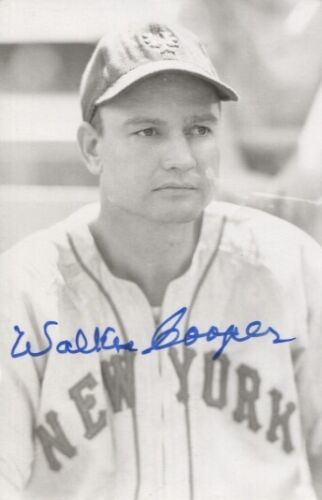Roundly considered the best catcher of the 1940s, Walker Cooper was a two-time World Series champ and 7-time All Star during the decade.
Cooper broke in with the St. Louis Cardinals during a six-game stint in 1940. Two years later he was their everyday backstop. That 1942 campaign was a dream season. The National League’s starting catcher in the All Star game Cooper hit .281 and finished in the NL’s top ten in doubles, triples, and slugging percentage.
Among the pitchers Cooper handled was his brother Mort, the NL MVP and league leader in wins (21), ERA (1.78), and shutouts (10). The siblings pushed the Cardinals to a 106-48-2 regular-season record and the 1942 World Series title.
In the Fall Classic against the defending champion New York Yankees Walker played a big role both on offense and defense. The catcher drove in the winning run in Game 4 and scored the go-ahead run in the top of the ninth in deciding Game 5.
In the bottom half of the frame Yankee second baseman and AL MVP Joe Gordon led off with a single. Bill Dickey came up next and reached on an error, putting the tying runs on base. Walker quickly dampened the Yankee hopes by picking Gordon off of second. St. Louis retired the next two New York batters to win the championship.
In ’43 Walker hit a career-high .318 and again started the All Star Game. Brother Mort topped NL pitchers in wins once more. Walker finished second to teammate Stan Musial in MVP balloting; Mort finished fifth. The Cardinals won 105 games and repeated as NL champs.
It was more of the same in ’44. Walker hit .317, started the All Star Game while Mort won 22. Both men finished in the top-10 in MVP balloting as St. Louis won their third-straight pennant and their second World Series title in three seasons. In 65 career plate appearances in World Series play, Cooper hit an even .300.
All but four games of his 1945 season were taken away by military service during World War II. Before he returned in ’46, the Giants purchased Walker Cooper’s contract from the Cardinals for $175,000, the most the franchise had ever spent on an acquisition. The move paid immediate dividends.
Cooper maintained his All Star form in each of his four seasons in the Big Apple. In 1947 he slugged 8 triples, 35 homers, and drove in 125 runs – all career highs. After a slow start in ’49, the Giants traded him to Cincinnati in June. He hit .280 for the Reds the rest of the season.
In the first 15 games of 1950, Cooper went 9-for-47, prompting the Reds to deal him to the Braves. The change of scenery did him good. In 102 games with Boston he hit .329 with a .389 on-base percentage and a .528 slugging mark, earning him his 8th and final All Star bid. The following season in ’51 Cooper slashed .313/.367/.518 in another outstanding campaign. He remained with the Braves until drawing his release in February, 1954, a month past his 39th birthday.
His days as an everyday catcher behind him, Cooper remained a valuable backup. In 71 games in ’54 he slashed .301/.389/.514 with a 133 OPS+. Fifty-four games with Chicago in 1955 resulted in a 129 OPS+. Cooper closed his career by returning to St. Louis for the ’56 and ’57 seasons.
Shown here is a government postcard from 1951 signed by Walker Cooper.










Upon retirement, Walker Cooper was among the best catchers in NL History.